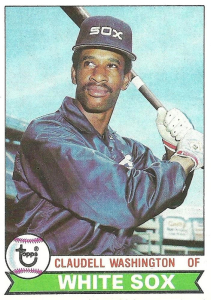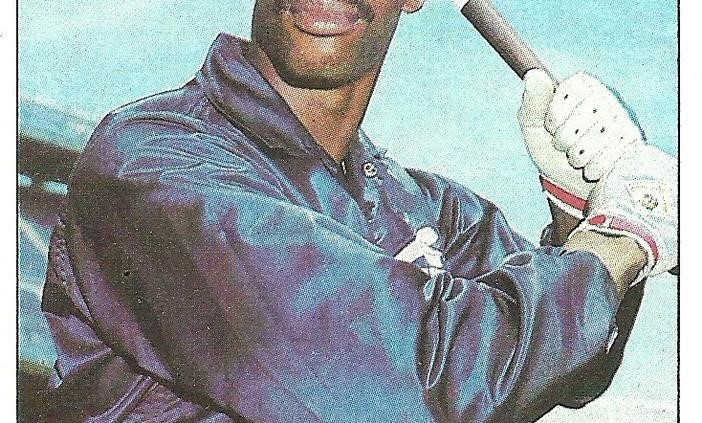August 11, 1979: White Sox slip, slide to win on ‘Comiskey Dunes’
 A photo in the August 12, 1979, edition of the Chicago Tribune summed up the previous day’s bizarre baseball action at Comiskey Park. White Sox right fielder Claudell Washington stood alone amid an apparent moonscape—on a field covered by a pocked layer of dust, rather than a carpet of grass.1
A photo in the August 12, 1979, edition of the Chicago Tribune summed up the previous day’s bizarre baseball action at Comiskey Park. White Sox right fielder Claudell Washington stood alone amid an apparent moonscape—on a field covered by a pocked layer of dust, rather than a carpet of grass.1
Faced with a soggy and damaged playing surface, the White Sox tried to prepare for a doubleheader with the Toronto Blue Jays by liberally covering the outfield with sand. It worked, to a point: The teams completed their scheduled doubleheader, and the White Sox won the first game, 6-1.
But owner Bill Veeck—who compared the field to the Sahara Desert—and the White Sox grounds crew earned no style points from players, writers, or the 19,420 fans on hand. One sportswriter dubbed the playing field “the Comiskey Dunes.”2 Referring to the Blue Jays’ status as a recently created expansion franchise, Washington grumbled: “I don’t think no other club but an expansion team would have gone out there today.”3
The White Sox came into the Saturday doubleheader with a 50-62 record, fifth in the American League West Division, 13 games behind the California Angels. Perhaps the season’s most notable event had taken place a month before, on July 12, when a Disco Demolition Night promotion at Comiskey turned into a crowd rampage that forced the team to forfeit the second game of a doubleheader against Detroit.
On August 2 manager Don Kessinger resigned and the White Sox replaced him with Tony La Russa. A 34-year-old former major-league infielder, La Russa had been managing the team’s Triple-A affiliate in Iowa when he was called to the big leagues. The White Sox were on a road trip when La Russa took over, and the doubleheader against Toronto was his first pair of home games as manager. The team had a 4-2 record under its new leader.
When he arrived in Chicago, La Russa did not find the team’s venerable ballpark in anywhere near its best shape. A multi-band rock concert headlined by Santana and Journey had played at Comiskey the previous weekend. The grounds crew was apparently unable to repair damage caused by the crowd, and a heavy downpour the day before the doubleheader made matters worse. Veeck also blamed runoff from one of Chicago’s landmark highways: “We’ve had a drainage problem here ever since they put in the Dan Ryan (Expressway). The water used to drain to the east. Now it drains from over there in our direction.”4
Into the soggy mess marched the Toronto Blue Jays, led by founding manager Roy Hartsfield in his third and final season with the team. The Jays had one of the worst records in the major leagues at 34-79 and were already 41½ games behind the AL East-leading Baltimore Orioles.5 The Blue Jays had gone 2-8 in their previous 10 games, though one of those wins had come against the White Sox on August 4. At season’s end, the team’s record stood at 53-109—even worse than the 54-107 mark posted by the inaugural Blue Jays team in 1977.6
Lefty Ken Kravec, toting a 10-10 record and a 4.14 ERA, got the first-game start for Chicago, while righty Jackson Todd opposed him for Toronto. Todd was making his first start of the season and only his second appearance. He brought no wins or losses and a 7.71 ERA into the game.
But the most important starters in each team’s lineup may have been Washington, Chet Lemon, and Alan Bannister for Chicago, and Bob Bailor, Rick Bosetti, and Otto Vélez for Toronto. From right to left, they were the outfielders who slipped and slid through the challenging “Comiskey dunes” in pursuit of fly balls and line drives. Bannister later likened the experience to “running on the beach,” while Bailor compared the “dangerous” conditions to the sandlots in his Pennsylvania hometown.7
Toronto started the game with a run-scoring burst. Shortstop Alfredo Griffin, Bailor, and third baseman Roy Howell hit consecutive singles to give Toronto a 1-0 lead. Game accounts do not indicate that Griffin and Bailor’s hits were sand-aided, and Howell’s single was an infield hit off the glove of first baseman Mike Squires.8 Designated hitter Rico Carty followed with a booming fly to deep center field that allowed Bailor to tag up and move to third.9 But Bailor got hung up in a rundown between third and home on Vélez’s groundball for the second out. Bosetti ended the inning with a grounder to shortstop.
Chicago bounced back in the bottom half, starting with a single to right field by leadoff hitter Squires. A wild pitch moved Squires to second, a groundball by Bannister advanced him to third, and a sacrifice fly to center field by second baseman Jorge Orta brought him in to tie the game. After the Blue Jays hit into a line-drive double play in the top of the second, the White Sox took a 2-1 lead on a solo home run by shortstop Greg Pryor, his second of the season.10
Through the next three innings, only one significant threat developed. In the fifth, Blue Jays second baseman Danny Ainge singled to shortstop, and a double by Griffin moved him to third. A fly ball by Bailor to Bannister in left field ended the inning there. Griffin’s double was one of 22 he hit that season. With a batting average of .287, he tied with Minnesota’s John Castino to jointly win the AL Rookie of the Year Award. (Ainge made his athletic reputation with the championship Boston Celtics basketball teams of the 1980s.)
Squires and Orta again figured into the White Sox’ next scoring rally, in the sixth. With one out, Todd hit Squires with a pitch. After another out, Orta hit his ninth home run of the year, to right-center field, to give Chicago a 4-1 lead.11
Both starting pitchers left the game in the eighth. Kravec walked Bailor and struck out Howell. He was then removed in favor of righty Ed Farmer, a midseason trade pickup from the Texas Rangers. Farmer got Carty to ground into an around-the-horn double play to end the inning. In the bottom half, Todd walked leadoff hitter Jim Morrison and was yanked for former San Diego Padres righty Dave Freisleben. Freisleben yielded an infield single to Squires, then two outs later gave up a two-run bad-hop single to designated hitter Lamar Johnson to make the score 6-1.12 Johnson hit safely in both games of the doubleheader to increase his hitting streak to 11, while center fielder Lemon had a 10-game streak snapped.13
Farmer made the end of the game exciting. He opened the ninth by giving up a single to center by Vélez, followed by back-to-back walks to Bosetti and first baseman Craig Kusick. Then he rebounded, getting catcher Rick Cerone to strike out looking and inducing Ainge to ground into a game-ending around-the-horn double play. The game ended in 2 hours and 19 minutes, with Kravec getting the win, Todd taking the loss, and Farmer earning his eighth save. Farmer led the White Sox in saves that season with 14.
The Blue Jays won the second game, 6-0, behind a four-hit complete game by rookie Dave Stieb, appearing in his ninth major-league game. It was Stieb’s fourth major-league win and the first of 30 shutouts in his 16-season career.
Chicago’s problems with field conditions only got worse as the season progressed. Unusually heavy rain and poor drainage later in August continued to wreak havoc on the field. Two additional concerts—the Beach Boys, Blondie, and other acts on August 18, and Rush, Foghat, and others on August 1914—probably didn’t help, although Veeck insisted that those crowds did not cause damage.15 In late August, umpires postponed three White Sox games in six days, saying the mucky conditions of the outfield were not safe for play.16
Veeck had rented out Comiskey for concerts as a source of income while his team was on the road. But postponements in 1979—both rain-related and concert-related—reportedly cost Veeck more money than he made from the concert business.17 Veeck put the team up for sale the following year, and a deal with businessmen Eddie Einhorn and Jerry Reinsdorf was announced in January 1981.18 The sale ended Veeck’s colorful career as a major league owner.
Acknowledgments
This article was fact-checked by Gary Belleville and copy-edited by Len Levin.
Sources
In addition to the sources cited in the Notes, the author used the Baseball-Reference.com and Retrosheet.org websites for general player, team and season data and the box scores for this game.
https://www.baseball-reference.com/boxes/CHA/CHA197908111.shtml
https://www.retrosheet.org/boxesetc/1979/B08111CHA1979.htm
Image of 1979 Topps card #574 downloaded from the Trading Card Database.
Notes
1 Walter Neal (photographer), Chicago Tribune, August 12, 1979: Section 4: 3.
2 David Condon, “It’s SoxFest Time at Comiskey Dunes,” Chicago Tribune, August 13, 1979: Section 5: 1.
3 Richard Dozer, “Sox, Toronto Split Amid Comiskey Park Ruins,” Chicago Tribune, August 12, 1979: Section 4: 3. The Blue Jays were playing their third season in the American League in 1979.
4 Dozer. The expressway, one of Chicago’s busiest roads, opened in 1961.
5 In the AL West, the Oakland Athletics had one more win than the Jays, but two more losses (35-81). The Blue Jays had the worst winning percentage in the majors by a narrow margin — .301 for Toronto, .302 for Oakland.
6 As of the end of the 2022 season, the 1979 Blue Jays’ winning percentage of .327 remained the worst in franchise history.
7 Dozer.
8 “Sox Scoring,” Chicago Tribune, August 12, 1979: Section 4: 9.
9 Dozer.
10 Wire services, “Pensacola Pair Does It ‘Right,’” Pensacola (Florida) News Journal, August 12, 1979: 8B.
11 Dozer.
12 “Sox Scoring.”
13 “Sox Notes,” Chicago Tribune, August 12, 1979: Section 4: 9.
14 Event listings, Rock Island (Illinois) Argus, August 12, 1979: 2 (Quad-Citian section).
15 Associated Press, “Drains Fight Rains in Vain,” Baltimore Sun, August 31, 1979: C13; Bill Jauss, “Veeck Feels Wronged by Fans’ Wrath,” Chicago Tribune, August 27, 1979: Section 5: 3.
16 Associated Press, “White Sox Singing Blues over Flooded Comiskey Park,” Lafayette (Indiana) Journal and Courier, August 31, 1979: B7.
17 Associated Press, “Drains Fight Rains in Vain.”
18 “White Sox Sale Imminent,” Hackensack (New Jersey) Record, January 7, 1981: D1.
Additional Stats
Chicago White Sox 6
Toronto Blue Jays 1
Game 1, DH
Comiskey Park
Chicago, IL
Box Score + PBP:
Corrections? Additions?
If you can help us improve this game story, contact us.


